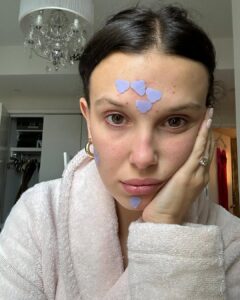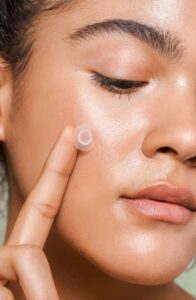If you’ve ever woken up to a glaring spot right before an important meeting or night out, chances are you’ve reached for a pimple patch. Those little transparent stickers (or the cute colourful ones) have become a skincare staple. All of us, including celebrities, have quickly jumped on the acne patch bandwagon, but how well do pimple patches actually work? More importantly, are you even using them right? To clear up the confusion, we spoke with dermatologist Dr Thalha, who broke down the facts on when pimple patches shine, when they fall short, and if they can be your best weapon to fight acne.
Related: Acne Control And Skincare Tips From Experts For Glowing And Healthy Skin
Do pimple patches work on blackheads and cysts?

“Pimple patches are a simple yet effective tool for managing certain types of acne,” says Dr Thalha. ”They’re brilliant on pimples with visible pus heads,” he explains. In those cases, the patch absorbs fluid, flattens the spot, and reduces redness. They also work well on freshly popped pimples (though more on that mistake later), helping mop up leftover fluid and shielding the wound. But here’s the catch: they won’t do much for cystic acne or blackheads; there’s simply nothing for the patch to absorb.
Types of pimple patches and which one to choose
Not all patches are created equal. You’ve got three types, and whether your pimple heals or not depends on your choice of pimple patch.
- Hydrocolloid patches – best for pus-filled spots.
- Medicated patches – active ingredients like salicylic acid, tea tree oil, or niacinamide make them more effective for red, inflamed papules.
- Microneedle patches – for stubborn spots, delivering actives under the skin.
What’s the right way to apply a pimple patch?

If you have been applying pimple patches and they don’t seem to work, chances are that you are applying them the wrong way. “Always begin by cleansing your face with a gentle, oil-free cleanser to remove dirt, oil, and any makeup or skincare residue,” says Dr Thalha. Don’t moisturise or apply any kind of other products before applying the patch. Once the area is dry, put the patch on the pimple. “Press gently around the edges to ensure a proper seal and then leave the patch on for the recommended duration without adjusting or touching it,” Dr Thalha instructs.
Can you apply a patch on popped pimples?
Tempting as it is, for god’s sake, don’t pop your pimples. “When it comes to whether you should pop a pimple, the answer is always no,” warns Dr Thalha. Popping increases the risk of scarring and spreading bacteria. But if you have just popped a pimple, clean it gently and immediately apply a hydrocolloid patch. The patch seals the wound, absorbs any remaining fluid, and keeps bacteria out.
Even if you have a regular active-acne routine, you should ditch it after committing the crime of popping a pimple. “For the first 24 hours after a spot has been popped, a plain hydrocolloid patch alone is often the gentlest and most effective option, after which you can return to your usual acne regimen,” Dr Thalha suggests.
How long to keep the patch on and what to do after removing it
The answer to this question depends on the kind of patch you’re using.
- Hydrocolloid patches should be left on for 6–12 hours, or until they turn opaque as they absorb fluid.
- Medicated patches should be left on for 4–8 hours or overnight. Follow the product instructions.
- Microneedle patches should be left on for 2–6 hours for optimal ingredient delivery.
Dr Thalha says, “Replace any patch once it has turned opaque or after about 12 hours, to minimise the risk of bacterial buildup.“
We often ignore aftercare, but it is equally important. “If the skin is still exposed or acne is still active, you can apply another patch,” Dr Thalha suggests. But if that’s not the case, gently cleanse the area to remove all the adhesive residue and apply a thin layer of moisturiser. And of course, don’t skip sunscreen if it’s daytime.
Is there a cheaper alternative to pimple patches?

If you don’t have a pimple patch but want to get rid of that sneaky pimple before a big event, here’s your budget alternative. “Bandages sold in the first aid aisle can work just as well as pimple patches because they’re made of the same core material,” says Dr Thalha. Not as discreet, but perfect for overnight treatment when you are not stepping out of the house.
Do pimple patches leave scars?
“For most people, pimple patches are low-risk and well-tolerated, but they’re not entirely risk-free,” Dr Thalha warns. Pimple patches might create some problems for people with sensitive skin, especially if they use medicated patches containing active ingredients. So, it’s better to avoid medicated patches if you have sensitive skin. Dr Thalha suggests doing a patch test before applying any type of pimple patch to your face, no matter your skin type. Remove the patch immediately if you notice swelling, severe redness, or blistering.
Are pimple patches the ultimate solution to acne?

Not quite. “Pimple patches are ideal for quick healing and protection of individual acne lesions, while creams and gels are more effective for long-term control and deeper acne,” Dr Thalha explains. He suggests using both according to time and need.
To connect with dermatologist Dr Mohammed Thalha for more personalised skin and hair care advice, find him here.
Featured Image Source

 Web Stories
Web Stories













